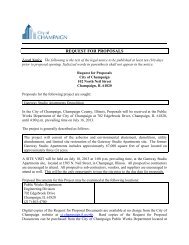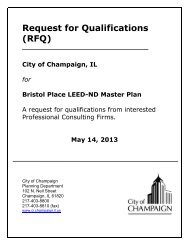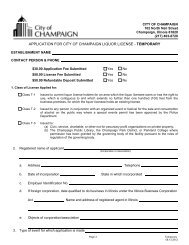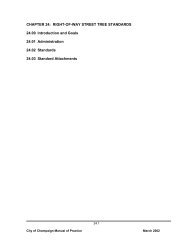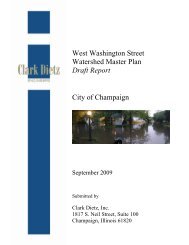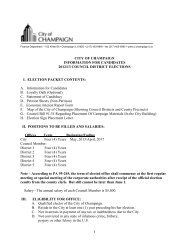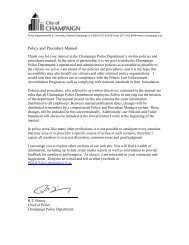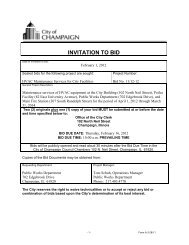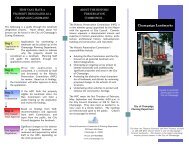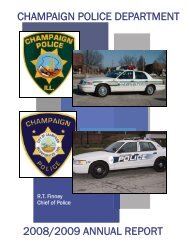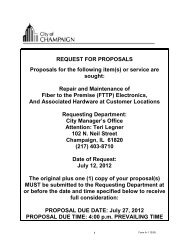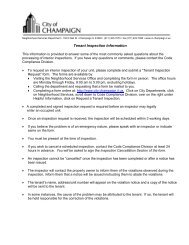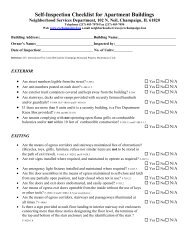2010-2014 Consolidated Plan - City of Champaign
2010-2014 Consolidated Plan - City of Champaign
2010-2014 Consolidated Plan - City of Champaign
You also want an ePaper? Increase the reach of your titles
YUMPU automatically turns print PDFs into web optimized ePapers that Google loves.
Redevelopment Initiatives – Commercial Areas Serving Underserved PopulationsThe following initiatives are currently being undertaken with the assistance <strong>of</strong> the <strong>City</strong> <strong>of</strong> <strong>Champaign</strong>.Although the <strong>City</strong>’s role consists primarily <strong>of</strong> infrastructure development, they are economic developmentinitiatives. For this reason, these initiatives are being addressed in this section <strong>of</strong> the <strong>Consolidated</strong> <strong>Plan</strong>.The <strong>City</strong>’s <strong>Plan</strong>ning Department has prepared detailed plans for each <strong>of</strong> the following initiatives. Theinformation provided here summarizes some <strong>of</strong> the key economic development needs and strategiesincluded in those documents.Downtown<strong>Champaign</strong>’s downtown area has been undergoing significant transformation from a retail and financialcenter to an entertainment (food and night life), <strong>of</strong>fice and residential area. In 1973, the majordepartment stores moved away from the downtown area to became anchors in a large, indoor mall onthe north edge <strong>of</strong> town. New <strong>of</strong>fice building construction on the fringes <strong>of</strong> the community in the 1980sreduced the marketability <strong>of</strong> the older, upper story spaces in the downtown. As in many oldercommunities, the downtown area <strong>of</strong> <strong>Champaign</strong> was primarily comprised <strong>of</strong> sparsely populated <strong>of</strong>ficebuildings, closed businesses, and little pedestrian traffic. Since then, several trendy bars, shops, andeating establishments have opened in the downtown area, bringing many more people into downtown.Two major construction projects have brought numerous businesses and high-end condos to thedowntown area. Council adopted a strategic plan in Council Bill 2006-128.http://archive.ci.champaign.il.us/archive/dsweb/Get/Document-4011/CB%202006-128.pdfNorth First StreetNorth First Street is an area comprised <strong>of</strong> several blocks <strong>of</strong> primarily commercial buildings at theeasternmost edge <strong>of</strong> the downtown area. Once a viable retail/commercial center, this area served theneeds <strong>of</strong> many residents <strong>of</strong> <strong>Champaign</strong>'s lower-income neighborhoods. However, by 1999, the area hadexperienced considerable disinvestment. Most <strong>of</strong> the buildings were deteriorated and abandoned. Acooperative effort <strong>of</strong> the area residents, business owners, and <strong>City</strong> staff resulted in an assessment <strong>of</strong>North First Street needs and the creation <strong>of</strong> objectives to address them. Since 2000, great strides havebeen made in the revitalization <strong>of</strong> North First Street. Several deteriorated structures have beenrehabilitated or demolished, new buildings have been constructed and new businesses have moved to thearea. In the upcoming 5 years, the <strong>City</strong> will encourage and assist with more infill development <strong>of</strong> the fewremaining parcels in the area. In addition, key strategies are being explored to link North First Street withDowntown to create one cohesive business district.Another problem facing the North First Street area was its negative image. The area contained manydeclining buildings and a deteriorated infrastructure, including a lack <strong>of</strong> pedestrian amenities. Due to theredevelopment efforts in the area, this perception is gradually changing. A legal aid <strong>of</strong>fice, barber shop,and chiropractic <strong>of</strong>fice have opened on North First Street. Pedestrian traffic is gradually returning to thearea.<strong>City</strong>-funded streetscape improvements were completed in 2003. The remaining vacant, deterioratingproperties are being acquired by the <strong>City</strong> through eminent domain where necessary. Owners who wish toinvest in their properties can receive a 50% match toward permanent improvements to the real estate,up to $150,000. A <strong>City</strong> initiative called the North First Street Redevelopment Incentive Program hashelped several applicants receive bank financing for new construction projects..East SideThe East Side shares a tax increment-financing district with North First Street. The East Side is an areathat stretches from the <strong>City</strong>’s Downtown area on the west to its easternmost border at Wright Street, and60 Needs Assessment: Non-Housing Community Development



